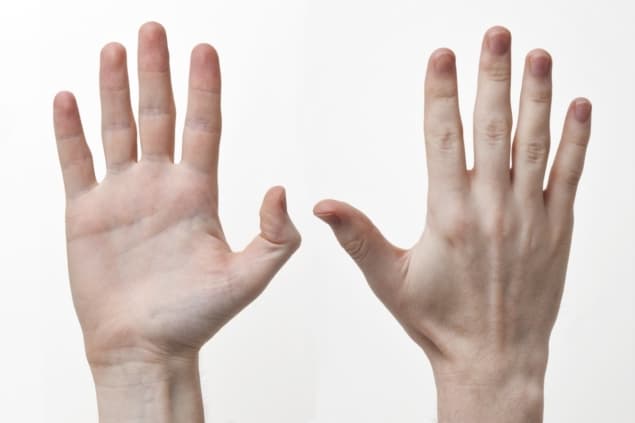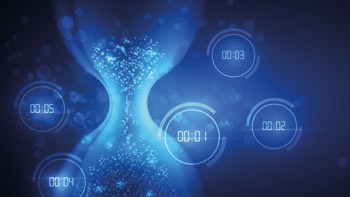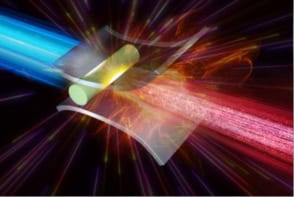
The human hand can be used as an infrared radiation (IR) source to decrypt hidden messages and register sign-language-style finger gestures, researchers in China have shown. The concept could find application in anticounterfeiting and gesture-driven control of devices.
The human body, like all matter, emits thermal radiation – specifically at infrared wavelengths (IR). While invisible to the naked eye, this emission can be seen using thermal imaging cameras and some night-vision goggles. The emissions from individual parts of the body are small but significant. An average hand, for example, puts out around 4 W of infrared power with an intensity of some 212 W/m2 – compared with 0.6 W and around 823 W/m2 for a standard LED.
In their study, materials scientists Tao Deng and Wen Shang of the Shanghai Jiao Tong University and colleagues set out to see if the low-level emissions from the human hand could be captured and put to a practical use.
Secret pattern
To this end, they took an aluminium surface – which has a high IR reflectivity – and stencilled on a pattern using a mix of hexane and polydimethylsiloxane, which has a low IR reflectivity. Under ambient light, the image they created is not discernible to the either human eye or an infrared camera. This situation changes, however, when the infrared light from a hand is shone over the secret pattern.
“When there is no hand, the coding pattern, including both the region of low IR reflectivity and region of high IR reflectivity, is in temperature equilibrium with the background,” the researchers say, explaining that the IR radiances from different regions are the same, resulting in no contrast between the pattern and the aluminium background.
However, they add, “when the human hand is used as the light source, the IR emission from the hand is reflected by all the regions, and thus, the region of high IR reflectivity has a higher increase of IR radiance than that of low IR reflectivity.” As a result, the pattern stands out to an infrared detector.
Encrypting information
By varying the depth of the polydimethylsiloxane layer, the team found that they were also able to varying the infrared reflectance of the pattern in specific areas – with thicker applications resulting in more absorption of the radiation and therefore a lower reflectivity. In this way, the team were able to encrypt more information into the pattern.
“The IR camera can automatically assign colours to the IR image to characterize the level of IR radiance from different areas,” Deng explains – meaning that the team are able to deposit patterns that, when processed can be turned into colourful images of flowers or patterns of human fingerprints and random shapes that might be used for unclonable security coding.
The system does have one limitation: as the ambient temperature rises (or one’s hands get colder), the reflectivity contrast decreases. The team propose a simple solution for this however – which is to rub your hands together to increase their temperature to compensate.
Individual digits
In the final part of the study, the team note that the movement of individual digits can effectively turn the human hand into a “powerless and multiplexed infrared light source”, one in which “the relative position and number of light sources are controllable and adjustable at will by changing hand gestures.” By combining an infrared camera with various specially tuned diffraction gratings, the team propose that a system could be set up to decipher hand gestures, either to serve as a form of passcode or to allow contact-less control of a device.

Octopus skin inspires new infrared reflector
“This is an interesting proposal and it is surprising that there is a discernible difference in the IR propagation from individual fingers. I would have thought that each digit would behave as a Lambertian emitter and so the spatial information would become lost at relatively short distances,” comments Howard Snelling – a physicist at the University of Hull who was not involved in the present study. Noting that the human hand is technically powered (“albeit by food!”), he adds: “It will be interesting to see if the detection system can be developed to simplify this scheme as much as the hand has for the source. Currently, the use of an IR camera adds considerable cost and reintroduces the need for external power.”
With their initial study complete, the researchers are now looking to both optimize the performance of their decryption and control systems, alongside explore new potential applications – especially within the field of human–machine interactions.
“Apart from sign language recognition [we demonstrated], this technique may also be used in human machine interaction for other applications – such as virtual game, virtual reality, smart home and office, vehicle control, and healthcare and medical assistance,” Deng says.
The study is described in Proceedings of the National Academy of Sciences.



